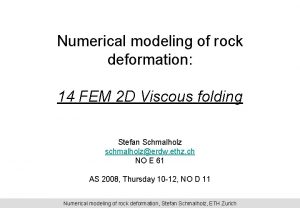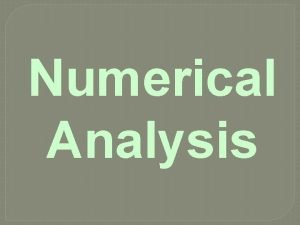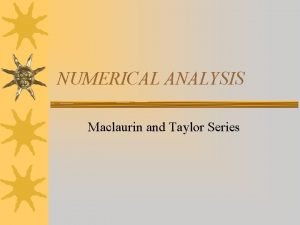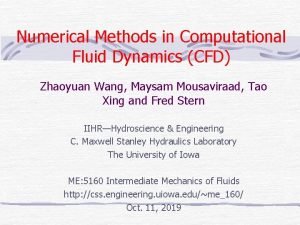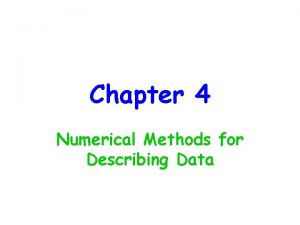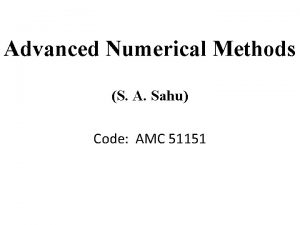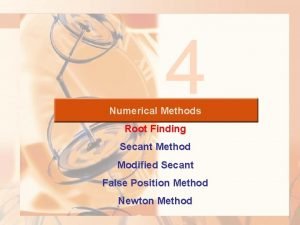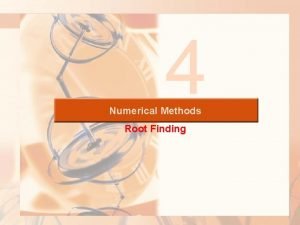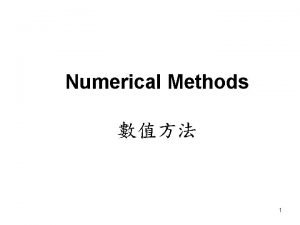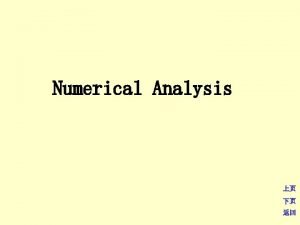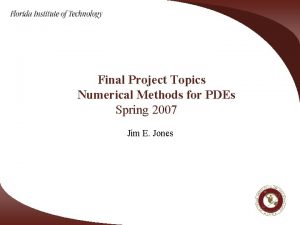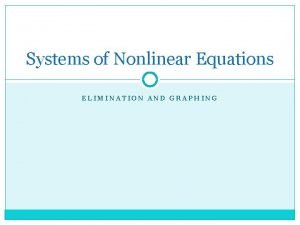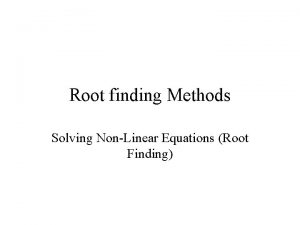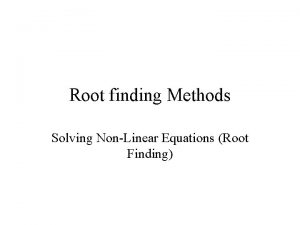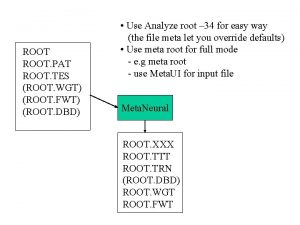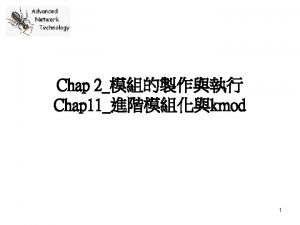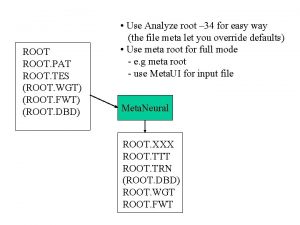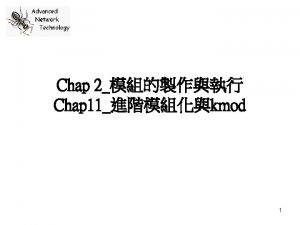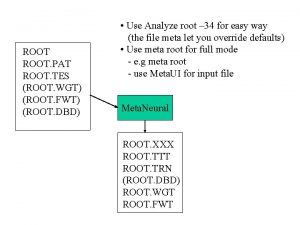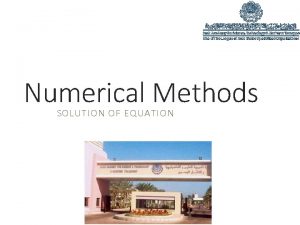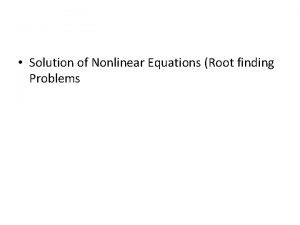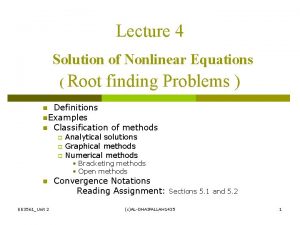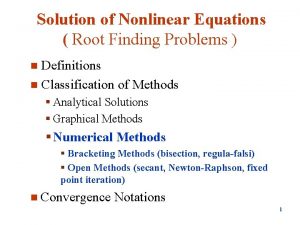Numerical Methods of Root finding 1 Nonlinear Equations





![False Position Method (Regula Falsi) Instead of bisecting the interval [x 0, x 1], False Position Method (Regula Falsi) Instead of bisecting the interval [x 0, x 1],](https://slidetodoc.com/presentation_image_h2/338ed057516194bd25ed13cc428d1514/image-6.jpg)











- Slides: 17

Numerical Methods of Root finding 1

Nonlinear Equations: Roots – Objective is to find a solution of F(x) = 0 Where F is a polynomial or a transcendental function, given explicitly. – Exact solutions are not possible for most equations. – A number x ± e, ( e > 0 ) is an approximate solution of the equation if there is a solution in the interval [x-e, x+e]. e is the maximum possible error in the approximate solution. – With unlimited resources, it is possible to find an approximate solution with arbitrarily small e. 2

Basis of root finding • An equation f(x)=0, where f(x) is a real continuous function, Theorem has at least one root between xl and xu if f(xl) f(xu) < 0. • Figure 1 At least one root exists between the two points if the function is real, continuous, and changes sign. 3

Bisection Method Let F(x) be a continuous function and let a and b be real numbers such that F(a) and F(b) have opposite signs. Then there is a x* in interval [a, b] such that F(x*) = 0. Then c = (a + b)/2 is an approximate solution with maximum possible error (b – a)/2. If f(c) and f(a) have opposite signs then the solution x* is in the interval [a, c]. Then, again, d = (c + a)/2 is an approximate solution but with max possible error (b – a)/4. Else the solution is in the interval [c, b]. The approximate solution now is (c+b)/2 with max possible error (b-a)/4. Continuing this process n times we can reduce the max possible error to (b-a)/2 n. 4

Algorithm (Bisection Method) 1. Input > 0 , m > 0, x 1 > x 0 so that f(x 0) f(x 1) < 0. Compute f 0 = f(x 0). k = 1 (iteration count) 2. Do { (a) Compute f 2 = f(x 2) = (b) If f 2 f 0 < 0 , set x 1= x 2 otherwise set x 0 = f 2 and f 0 = f 2. (c) Set k = k+1. } 3. While |f 2| > and k m set x = x 2 , the root.
![False Position Method Regula Falsi Instead of bisecting the interval x 0 x 1 False Position Method (Regula Falsi) Instead of bisecting the interval [x 0, x 1],](https://slidetodoc.com/presentation_image_h2/338ed057516194bd25ed13cc428d1514/image-6.jpg)
False Position Method (Regula Falsi) Instead of bisecting the interval [x 0, x 1], we choose the point where the straight line through the end points meet the xaxis as x 2 and bracket the root with [x 0, x 2] or [x 2, x 1] depending on the sign of f(x 2).

False Position Method y y=f(x) (x 1, f 1) (x 2, f 2) x 0 x 2 (x 0, f 0) Straight line through (x 0, f 0) , (x 1, f 1) : x 1 x

False Position Method (Algorithm) 1. Choose > 0 (tolerance on |f(x)| ) m > 0 (maximum number of iterations ) k = 1 (iteration count) x 0 , x 1 (so that f 0 , f 1 < 0) 2. { a. Compute f 2 = f(x 2) b. If f 0 f 2 < 0 set x 1 = x 2 , f 0 = f 2 c. k = k+1 } 3. While (|f 2| ) and (k m) 4. x = x 2 , the root.

Newton-Raphson Method At an approximate xk to the root , the curve is approximated by the tangent to the curve at xk and the next approximation xk+1 is the point where the tangent meets the x-axis. y root y = f(x) x 2 x 1 x 0 x

Tangent at (xk, fk) : y = f(xk) + f ´(xk)(x-xk) This tangent cuts the x-axis at xk+1 Warning : If f´(xk) is very small , method fails. • Two function Evaluations per iteration

Newton’s Method - Algorithm 1. Choose > 0 (function tolerance |f(x)| < ) m > 0 (Maximum number of iterations) x 0 - initial approximation k - iteration count Compute f(x 0) 2. Do { q = f (x 0) (evaluate derivative at x 0) x 1= x 0 - f 0/q x 0 = x 1 f 0 = f(x 0) k = k+1 } 3. While (|f 0| ) and (k m) 4. x = x 1 the root.

Getting caught in a cycle of Newton’s Method y xk+ 1 xk Alternate iterations fall at the same point. No Convergence. x

Newton’s Method for finding the square root of a number x = a f(x) = x 2 - a 2 = 0 Example : a = 5 , initial approximation x 0 = 2. x 1 = 2. 25 x 2 = 2. 236111111 x 3 = 2. 236067978 x 4 = 2. 236067978

The secant Method • The Newton’s Method requires 2 function evaluations (f, f ). • The Secant Method requires only 1 function evaluation and converges as fast as Newton’s Method at a simple root. • Start with two points x 0, x 1 near the root (no need for bracketing the root as in Bisection Method or Regula Falsi Method). • xk-1 is dropped once xk+1 is obtained.

Secant Method (Geometrical Construction) y y= f(x 1) x 2 x 0 (x 0, f 0) x 1 x (x 1, f 1) • Two initial points x 0, x 1 are chosen • The next approximation x 2 is the point where the straight line joining (x 0, f 0) and (x 1, f 1) meet the x-axis • Take (x 1, x 2) and repeat.

The secant Method (Pseudo Code) 1. Choose > 0 (function tolerance |f(x)| ) m > 0 (Maximum number of iterations) x 0 , x 1 (Two initial points near the root ) f 0 = f(x 0) f 1 = f(x 1) k = 1 (iteration count) 2. Do { x 0 = x 1 f 0 = f 1 x 1= x 2 f 1 = f(x 2) k = k+1 } 3. While (|f 1| ) and (m k)

General remarks on Convergence # The false position method in general converges faster than the bisection method. # The bisection method and the false position method are guaranteed for convergence. # The secant method and the Newton-Raphson method are not guaranteed for convergence.
 Numerical methods for partial differential equations eth
Numerical methods for partial differential equations eth General solutions differential equations
General solutions differential equations Graphical and numerical methods
Graphical and numerical methods Newton gregory forward interpolation formula can be used
Newton gregory forward interpolation formula can be used Taylor series numerical methods
Taylor series numerical methods Types of errors in numerical computation
Types of errors in numerical computation Modified euler method formula
Modified euler method formula What is cfl number in cfd
What is cfl number in cfd Chronicle of higher education
Chronicle of higher education Descriptive statistics numerical measures
Descriptive statistics numerical measures Stirling interpolation formula proof
Stirling interpolation formula proof Modified secant method
Modified secant method Fixed point iteration method
Fixed point iteration method Numerical methods
Numerical methods Errors in numerical methods
Errors in numerical methods Interpolation in numerical methods
Interpolation in numerical methods Pde project topics
Pde project topics Solving systems of nonlinear equations by elimination
Solving systems of nonlinear equations by elimination
